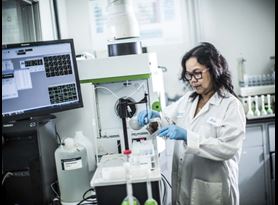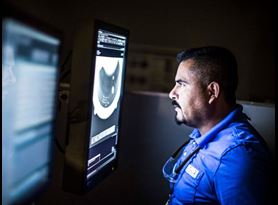Macro etching non-destructive testing method
Macro etch (also known as chem etch, chemical etch and chemical dissolution) can be used for both cleaning and inspection and is applicable to nickel and titanium based alloys.
The purpose of macro etching
As a non-destructive testing (NDT) method, macro etch is used to expose grains for evaluation so the grains can be inspected for size and flow, as well as overheat conditions. Macro etching can be used to detect material segregations in nickel-based alloys (such as white spots, “freckles”, in black smut condition) and can also be used to detect gross material segregations in titanium.
Macro etching laboratory inspection service
Element has the complete in-house capability of equipment, chemicals, procedures, qualified personnel, waste treatment, environmental related permits and industry certifications to accomplish high quality chemical etch processing for the following specifications:
- EIM Code 2 Method E
- EIM Code 2 Method F
- EIM Code 2 Method G
- EIM Code 2 Method H (see Aluminum Etch)
- EIM Code 2 Method X
- EIM Code 7 (chem milling)
- MTV 238
- LHP6017
- EMS52390
- RPS674
- DMC 0320
- DMC 0324
- DMC 0330
- DMP12-107
- DMP13-049 (Ti pickling)
- CP3605
- AMS 2643
- P4TF2
- P4TF3
- P4TF4
- P4TF8 (swab etch)
- C5049 (Ti cleaning)
- PWA 116 (Ti cleaning)
- RRP 51001
Macro etching can also be used on all critical rotating parts, fan blades, compressor blades, compressor vanes, fan cases, discs, disks, housings, sonic shape forgings, splines, shafts, hubs, engine cases, segments, spacers, flanges, links, rings, castings, and more.
For more information about our macro etching services, or to request a quote, contact us today.
Related Services

Anodic Etching Inspection
Anodic etch is only applicable to stainless steel and nickel-based materials. This nickel alloy inspection method is used to detect surface defects, grain structure, grain size and more.

Aluminium Etching and Cleaning
Aluminum etching is a nondestructive technique used to clean or inspect the material for grain size or surface defects. It is also considered a preparation method for pre-penetrant etch.

Chemical Analysis
Find out more about our chemical analysis laboratories that offer a critical resource for both material and product manufacturers.

Non-Destructive Testing (NDT)
Find out about the range of NDT services Element uses to evaluate the properties of a material, parts, products, welds, or systems without materially affecting the integrity of the items being tested.
